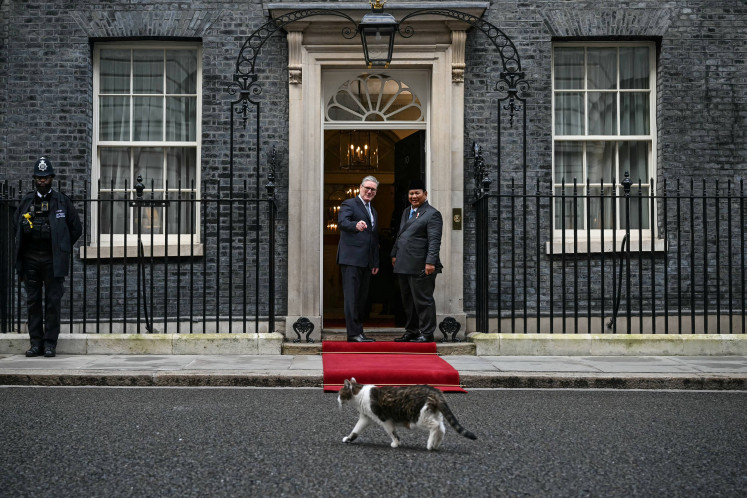Popular Reads
Top Results
Can't find what you're looking for?
View all search resultsPopular Reads
Top Results
Can't find what you're looking for?
View all search resultsBI to continue easing amid slow global growth, soft inflation
Destry Damayanty (Courtesy of LPS)Bank Indonesia (BI) will continue monetary easing using rate and non-rate tools to help jack up domestic economic growth against the backdrop of a global economic slowdown and benign consumer prices
Change text size
Gift Premium Articles
to Anyone
Destry Damayanty (Courtesy of LPS)
Bank Indonesia (BI) will continue monetary easing using rate and non-rate tools to help jack up domestic economic growth against the backdrop of a global economic slowdown and benign consumer prices.
“Our stance for easing policies would remain,” said BI senior deputy governor Destry Damayanty in a recent interview with The Jakarta Post. “We can also [further] lower our rate as there’s still room.”
From the United States to Asian countries, central banks have been slashing their monetary policy rates in recent months to stoke domestic economic growth in the face of what could well turn out to be a global recession stemming from trade tensions around the world.
BI has lowered its policy rate, the seven-day reverse repo rate, by 50 basis points (bps) in the past two months to 5.5 percent. BI Governor Perry Warjiyo said after BI’s monthly policy meeting in Aug. 22 that the move was a preemptive decision to encourage the domestic economy amid a potential global slowdown.
“But does policy easing always involve cutting interest rates? Not necessarily, because we have our policy mix,” said Destry, an economist by trade and commission member of the Insurance Deposit Corporation (LPS) who was the chief economist of state-run Bank Mandiri and Mandiri Sekuritas for 10 years.
Nonmonetary tools such as the loan-to-value (LTV) ratio will be reviewed, with BI recently hinting at a relaxation of the LTV and down payment requirements for “green financing”.
Destry declined to elaborate on the plan, saying that studies were still underway to formulate a relaxation policy.
The central bank is also exploring the possibility to review the requirement for 20 percent of banks’ lending portfolios to be directed to small and medium enterprises (SMEs), a well-meaning policy that has the downside of discouraging banks from channeling more loans and preferring to pay penalties instead, she added.
Both monetary and nonmonetary policy tools were equally being considered by the central bank in its policy mix calibration, according to Destry, who was nominated by President Joko “Jokowi” Widodo for the senior deputy governor role after being appointed to lead the Corruption Eradication Commission (KPK) selection committee in 2015.
BI previously eased its primary reserve requirement (GWM), the ratio of banking liquidity held in the central bank’s reserves, among other macroprudential policies, by 50 (bps) to 6 percent for conventional banks and 4.5 percent for sharia banks as part of its accommodative macroprudential policies.
“Macroprudential [nonrate] tools could be more effective in accelerating economic growth,” said UOB Indonesia economics and research head Enrico Tanuwidjaja, projecting an additional 50 bps rate cut until the end of the year coupled with nonrate policy easing to boost domestic economic activities.
Indonesia’s economy grew at 5.05 percent year-on-year (yoy) in the second quarter, the lowest level in two years.
However, Enrico warned that the central bank would need to keep an eye on the potential risk of a capital outflow if rates were too low, especially with persisting problems with the current account deficit.
The World Bank recently projected that a recession “looks increasingly likely” with data from the US, China and European countries showing weaknesses. Indonesia’s economy could drop below 5 percent under the scenario, according to the Washington-based bank.
Destry projected that central banks of advanced economies will have fewer options than to adopt an easing stance for their policy in a bid to spur economic growth, considering such economies would eventually have to deal with the natural decline of gross domestic product expansion due to, among other factors, an aging population.
That would, in turn, result in an environment of persistent low interest rates around the world, which could present an opportunity for Indonesian assets to be seen as attractive with their high yields.
The spread between benchmark Indonesian bond yields and monetary policy rates versus the US remain wide, and a lowering credit default swap trend will make Indonesian assets and yields remain attractive, hence supporting the easing stance.
“The positioning of our asset classes compared to other countries is not bad. [Indonesia’s financial assets] remain attractive, which is why we were confident to lower the rate [in August],” Destry added.
Center of Reform on Economics (CORE) Indonesia research director Piter Abdullah agreed that Indonesia’s financial assets would still be considered attractive by investors amid a globally dovish trend in interest rates.
Apart from attractive yields, stable inflation and the need to jack up the domestic economy are primary supporting factors of the central bank’s easing stance, Destry said.
The consumer prices index (CPI), which measures inflation, stood at 3.49 percent in August yoy, well within BI’s target this year of inflation between 2.5 and 4.5 percent.










